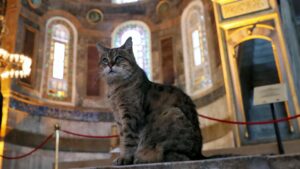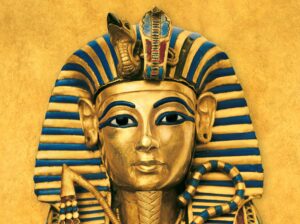Amineddoleh & Associates LLC Spring 2022 Newsletter
In our spring newsletter, Amineddoleh & Associates LLC is pleased to share some exciting developments that took place at the firm during the past winter.
LITIGATION UPDATES

The mural in Des Moines, Iowa shown in the Super Bowl commercial.
Chris “CAW” Williams, Maze, 2018
Amineddoleh and Associates LLC is representing Iowa-based muralist Chris Williams in a case against the Midwest grocery chain, Hy-Vee. Williams’ mural in downtown Des Moines, Iowa was featured in a 2019 Superbowl advertisement promoting Hy-Vee’s partnership with Oprah Winfrey’s O, That’s Good! Brand without the artist’s authorization. The case involves copyright law and VARA (the Visual Artists Rights Act), given the defendants’ unlicensed use of the image and lack of credit to Williams as the artist of the mural. The lawsuit seeks damages for the unlawful commercial use and appropriation use of Mr. Williams’ work. Read about the litigation in an article published by The Art Newspaper here and for more details, you can go to our website.
ART & IP NEWS
Cultural Heritage and Art in Ukraine
The world watched anxiously as tensions rose, and then erupted, between Russia and Ukraine in late February. The conflict between Russia and Ukraine has led to the most tragic casualty, the widespread loss of human lives. As this horror unfolds, art world professionals are also concerned about the loss of art and heritage while the conflict rages. We published a blog post delving into the risks to art collections, museums, cultural sites, as well as other art and heritage in Ukraine posed by the conflict. It is available here. Several days later, we were disheartened to confirm that the conflict resulted in the destruction of 25 artworks by renowned Ukrainian artist, Maria Prymachenko, after a museum in Ivankiv burned down.
Restitution of Mexican Antiquities
Cultural heritage is also at risk across the Atlantic Ocean. We published a blog post discussing how Pre-Columbian/Pre-Hispanic objects are often looted or smuggled from Latin America due to their high resale value and sold abroad. Recently, however, Mexico has taken several steps to recover its cultural artifacts and enforce national patrimony laws. Read more about the restitution of Mexican antiquities and the role of international cooperation on our website.
Dealer with Ties to Looted Antiquities Detained in Paris
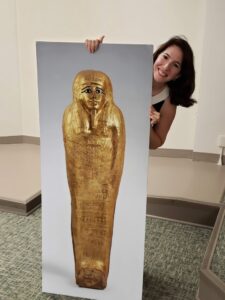
Leila Amineddoleh at the repatriation ceremony in 2020 in her role as the Egyptian cultural heritage law expert.
Roben Dib, a dealer suspected of supplying high-profile museums (including the Metropolitan Museum of Art in New York and the Louvre Abu Dhabi) with looted antiquities, was recently transferred to France to face charges of gang fraud and money laundering. Authorities believe that Dib acted through an intermediary (expert Christophe Kunicki) to engage in the large-scale trafficking of looted artifacts from Egypt and the Middle East. Previously, Kunicki had sold a looted golden sarcophagus to the Metropolitan museum for €3.5 million. A subsequent criminal investigation by Assistant District Attorney Col. Matthew Bogdanos exposed serious flaws in the museum’s provenance research, after which the museum issued an apology and formally repatriated the sarcophagus. Our founder served as the Egyptian cultural heritage law expert in this matter and attended the repatriation ceremony in 2020. You can read more about the sarcophagus’ journey here.
LAW FIRM UPDATES AND EVENTS
Art Law Conferences
In March, our firm’s founder, Leila Amineddoleh, served as a panelist at Notre Dame’s Journal of International and Comparative Law Symposium. At the symposium, “International and Comparative Approaches to Culture”, Leila discussed antiquities disputes and repatriation of cultural heritage.
At the end of March, Leila served as the keynote speaker at Yale University’s conference, “Dura-Europos: Past, Present, Future.” This event focused on the systematic looting of Dura-Europos that took place during the Syrian civil war. Specifically, Leila presented on the history of cultural heritage looting and modern efforts to prevent such plunder. Read more about this conference here.
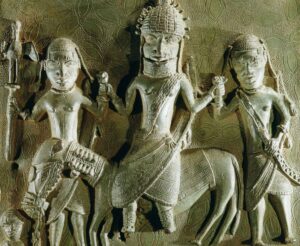
Examples of Benin Bronzes, looted art from Africa at the center of repatriation discussions.
Photo courtesy of Getty Images
Additionally, in January Leila participated in the webinar “Repatriation of African Artifacts: A Challenge for History and Property Rights,” hosted by African Liberty. The restitution of looted artifacts from Africa has formed part of an ongoing debate in several countries, particularly in Europe and the US (as former colonial powers). Leila discussed the recent focus on remedies for these issues, particularly the repatriation of the objects to their countries of origins and the grounds for doing so. We previously explored the subject of the Benin Bronzes in our ongoing Provenance Series, which you can access here.
Upcoming Conferences
This spring, we have additional conferences at which members of our firm will be speaking to look forward to.
Our associate, Claudia Quinones, will be presenting at a workshop organized by The European Society of International Law (ESIL) Interest Group ‘The EU as a Global Actor’ (IG EUGLOBAL). The event will be hosted by the University of Glasgow and focuses on “International Law and Global Security: Regulating an Illusion?”. Specifically, Claudia will speak on ‘Cultural Protection as a Key Component of Global Security.’ Information about the event can be found here.
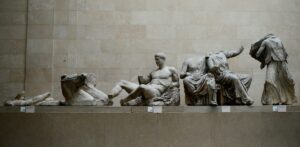
The Parthenon Marbles on display at the British Museum in London.
Photo Credit: Dylan Martinez/Reuters
Leila will also bring her expertise as a speaker to the 28th Annual Cultural Property Conference at Cardozo School of Law. As part of a panel on cultural property and international human rights trends, Leila will discuss the policies and polities of the Parthenon Marbles. Register and read more about this conference here, and learn more about the Parthenon Marbles on our website.
We look forward to both Leila’s and Claudia’s discussions at these upcoming events.
Art Law Publications
A number of recent cases have left some artists uneasy about the scope of the Fair Use Exception and the use of copyrighted materials in appropriation art. This has led to a shift in the landscape of copyright law. In fact, last month the U.S. Supreme agreed to hear arguments in the closely-watched case involving the Warhol Foundation. Leila commented on these shifts to the legal landscape in an article she wrote for the Institute of Art & Law titled “Fair Use in US Law: The Path to Marano v. Metropolitan Museum of Art.” Please contact us or the Institute of Art & Law for a copy of Leila’s informative article.
Associate Claudia Quinones was also published in the Santander Art and Culture Law Review (SAACLR). Her article, “On the Borderline – Using National and International Legal Frameworks to Address the Traffic of Pre-Columbian Antiquities between Mexico and the United States,” discusses historical and recent approaches to the illicit traffic of antiquities originating in Mexico. It further explores legal and non-legal remedies to curb this traffic. You can read her article on the SAACLR website.
CLIENTS AND REPRESENTATIVE MATTERS
Leader in the NFT Market

World’s first NFT vending machine
As discussed in our last newsletter, Amineddoleh and Associates has been one of the first law firms to work in the NFT space – both through our creation of the unique purchase and sale agreement for NFTs. Our clients include Monax, Nifty Gateway, private buyers and sellers, and corporations involved in investing in these assets. Our founder has also participated in a number of conferences focused on this topic, at locations including the University of Zurich, the Foundation for Art Law, and the New Museum in New York City.
As NFTs continue to dominate the art market, Leila had the opportunity to talk with the Associated Press about the world’s first NFT vending machine.
Music Spotlight
Art law encompasses any artistic expressions, including music. We have written a number of blog posts discussing the protection of musical instruments as well as the provenance of musical instruments and manuscripts. Given our passion for the subject, we are excited to announce that Amineddoleh and Associates is currently working on a number of music related matters.
The first matter involves valuable stolen classical music instruments which we are seeking to return to their rightful owner (our client).
In addition to working with a number of high-profile clients on their intellectual property portfolios, our firm is also representing Danish-born producer and songwriter Jonas Jeberg, known for writing and producing songs like Panic! At the Disco’s “High Hopes”, the Jonas Brothers’ “Rollercoaster,” Demi Lovato’s “You Don’t Do It For Me Anymore,” and Selena Gomez’s “Fetish” ft. Gucci Mane, as well as many others. Amineddoleh and Associates is advising Jeberg on his trademark portfolio.
Upcoming Happenings
After our client’s successful sale of a work by David Hammons at Sotheby’s in March (a sale that realized a price greater than the projected estimate), our client has three additional works that will be up for auction at Sotheby’s Contemporary Evening Sale in May. We look forward to attending this auction as the art market continues its post-pandemic upswing.
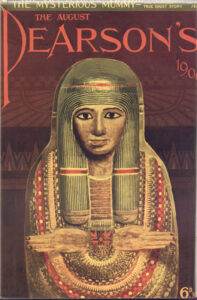
 One of the more sensational stories is that the mummy board was on the SS Titanic in 1912 and
One of the more sensational stories is that the mummy board was on the SS Titanic in 1912 and 
